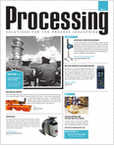Subscribe FREE - Processing Magazine
 Earlier post "Back Pressure Affect Conventional PSV Set Pressure : Case Study #1 - Bonnect Vent to ATM" has discussed how backpressure affects a conventional type Pressure Relief Valve (PSV) with bonnet vent to ATM and checks required to ensure the system is healthy.
Earlier post "Back Pressure Affect Conventional PSV Set Pressure : Case Study #1 - Bonnect Vent to ATM" has discussed how backpressure affects a conventional type Pressure Relief Valve (PSV) with bonnet vent to ATM and checks required to ensure the system is healthy.Similarly this post is a case study for a conventional type PSV with non-bonnet vent (bonnet vent to flare system). Let take the similar conditions as per case study #1 for easy comparison.
"A Pressure Relief Valve (PSV) is conventional type with bonnet vent to atmosphere. This PSV is protection a pressure vessel with pre-specified design pressure of 7 barg. Maximum expected operating pressure (MOP) of the system is about 6.2 barg. The vessel has a maximum allowable working pressure (MAWP) of 8 barg. The normal continuous superimposed back pressure (PBs) is zero barg (atmosphere). PSV set pressure (Pset) has been adjusted to be inline with design pressure (DP) of 7 barg. The PSV spring has been pre-set to open when the pressure is reach 7 barg. Disc area (Ad) and nozzle area (An) are 113mm2 and 71mm2 respectively (for illustration purpose only).
Plant debottlenecking has introduced a new Pressure control valve (PCV) continuous releasing vapor into the common flare header as the PSV. This has resulted a constant superimposed back pressure of 0.3 barg. As per early post "How Back Pressure Affect Conventional PSV Set Pressure Subject to It Vent", increases in superimposed back pressure will increase opening pressure of conventional PSV (open at higher pressure), is the system still healthy ?"
From above system description;
- PSV type : Conventional type PSV with non-bonnet vent (bonnet vent to Flare).
- DP = 7 barg
- Pset (=Pv) = 7 barg
- MOP = 6.2 barg
- MAWP = 8 barg
- PBs,norm = zero barg (atmosphere)
- Ad = 113 mm2
- An = 71 mm2
The spring has been pre-set to open at DP = 7 barg and expected to reach complete opening at/below 7.7 barg.
After debottlenecking...
With superimposed back pressure, Pbs=0,
==> Fs = (Pv - Pb)An
==> Fs = (Pv - 0)An
==> Fs = PvAn
==> Fs = (Pv - 0)An
==> Fs = PvAn
After debottlenecking and new PCV results increased superimposed back pressure to P'b=Pbs=0.3 barg,
(P'v is new pressure causing PSV starts to open)
==> P'vAn = Fs + P'bAn
==> P'vAn = PvAn + P'bAn
==> P'v = Pv + P'b
==> P'v = 7 + 0.3
==> P'v = 7.3 barg
Thus, PSV will only open at P'v = 7.3 barg.
MOP / P'v = 6.2 / 7.3 = 84.9% < 90%. This is OK for conventional type PSV.
Built-up back pressure (Pbb) shall be calculated (say 0.4 barg),
Pbb / P'v = 0.4 / 7.3 = 5.5% < 10%. This is still OK for conventional type PSV.
As the opening pressure P'v=7.3 barg < MAWP of 8 barg, it is still OK.
After PSV set pressure is reset...
On the other hand, if operator would like to reset the PSV setting (F's) in order the PSV to open at 7 barg with superimposed back pressure of 0.3 barg, another assessment where the PCV is offline shall be checked. When PCV is offline, Pb = 0 barg.
After reseting, P'v = 7 barg, P'b = 0.3 barg,
==> P'vAn = Fs + P'bAn
==> F's = P'vAn - P'bAn
When PCV is offline, superimposed back pressure will drop to P"b=0 barg,
with new opening pressure of P"v,
==> P"vAn = F's + P"bAn
==> P"vAn = P'vAn - P'bAn + P"bAn
==> P"v = P'v - P'b + P"b
==> P"v = 7 - 0.3 + 0
==> P"v = 6.7 barg
The new opening pressure will potentially decrease to 6.7 barg.
MOP / P'v = 6.2 / 6.7 = 92.5% > 90%. This may not be aacceptable for conventional type PSV. Shall take effort to check with PSV vendor for confirmation.
Built-up back pressure (Pbb = 0.4 barg),
Pbb / P'v = 0.4 / 6.7 = 5.8% < 10%. This is still OK for conventional type PSV.
Thus, under this case, it is not advisable to reset the spring.
Observations
In this case study, there are some observation can be deduced :
- A conventional type PSV with non-bonnet vent (vent to flare), increases in superimposed back pressure will increase opening pressure of conventional PSV (open at higher pressure). It shall always be confirmed with MAWP of the protected system.
- In case above healthy criteria can not be met, may consider reset the PSV spring setting in order to decrease the set pressure of PSV
- With decrease in set pressure, it may results premature opening of PSV with earlier superimposed back pressure. This shall always check with if this is acceptable.
- Back Pressure Affect Conventional PSV Set Pressure : Case Study #1 - Bonnect Vent to ATM
- How Back Pressure Affect Conventional PSV Set Pressure Subject to It Vent
- Several Impact of Backpressure on Conventional PSV
- Simple Flow Chart to Determine Requirement of Thermal Relief
- Why Rupture (RD) Upstream of Pressure Relief Valve (PRV) ?
- Why Two Rupture Discs in Series ?
- Tube Rupture : Pressure Relief Valve (PSV) or Rupture Disk (RD) ?
- Criteria for Requirement of Pressure Relief Device for Tube Rupture

No comments:
Post a Comment